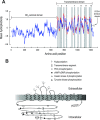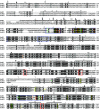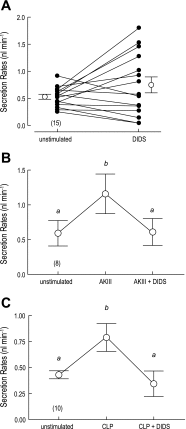A SLC4-like anion exchanger from renal tubules of the mosquito (Aedes aegypti): evidence for a novel role of stellate cells in diuretic fluid secretion
- PMID: 20042685
- PMCID: PMC2838654
- DOI: 10.1152/ajpregu.00729.2009
A SLC4-like anion exchanger from renal tubules of the mosquito (Aedes aegypti): evidence for a novel role of stellate cells in diuretic fluid secretion
Abstract
Transepithelial fluid secretion across the renal (Malpighian) tubule epithelium of the mosquito (Aedes aegypti) is energized by the vacuolar-type (V-type) H(+)-ATPase and not the Na(+)-K(+)-ATPase. Located at the apical membrane of principal cells, the V-type H(+)-ATPase translocates protons from the cytoplasm to the tubule lumen. Secreted protons are likely to derive from metabolic H(2)CO(3), which raises questions about the handling of HCO(3)(-) by principal cells. Accordingly, we tested the hypothesis that a Cl/HCO(3) anion exchanger (AE) related to the solute-linked carrier 4 (SLC4) superfamily mediates the extrusion of HCO(3)(-) across the basal membrane of principal cells. We began by cloning from Aedes Malpighian tubules a full-length cDNA encoding an SLC4-like AE, termed AeAE. When expressed heterologously in Xenopus oocytes, AeAE is both N- and O-glycosylated and mediates Na(+)-independent intracellular pH changes that are sensitive to extracellular Cl(-) concentration and to DIDS. In Aedes Malpighian tubules, AeAE is expressed as two distinct forms: one is O-glycosylated, and the other is N-glycosylated. Significantly, AeAE immunoreactivity localizes to the basal regions of stellate cells but not principal cells. Concentrations of DIDS that inhibit AeAE activity in Xenopus oocytes have no effects on the unstimulated rates of fluid secretion mediated by Malpighian tubules as measured by the Ramsay assay. However, in Malpighian tubules stimulated with kinin or calcitonin-like diuretic peptides, DIDS reduces the diuretic rates of fluid secretion to basal levels. In conclusion, Aedes Malpighian tubules express AeAE in the basal region of stellate cells, where this transporter may participate in producing diuretic rates of transepithelial fluid secretion.
Figures














Similar articles
-
Transcellular and paracellular pathways of transepithelial fluid secretion in Malpighian (renal) tubules of the yellow fever mosquito Aedes aegypti.Acta Physiol (Oxf). 2011 Jul;202(3):387-407. doi: 10.1111/j.1748-1716.2010.02195.x. Epub 2010 Nov 16. Acta Physiol (Oxf). 2011. PMID: 20946239 Free PMC article. Review.
-
Role of an apical K,Cl cotransporter in urine formation by renal tubules of the yellow fever mosquito (Aedes aegypti).Am J Physiol Regul Integr Comp Physiol. 2011 Nov;301(5):R1318-37. doi: 10.1152/ajpregu.00223.2011. Epub 2011 Aug 3. Am J Physiol Regul Integr Comp Physiol. 2011. PMID: 21813871 Free PMC article.
-
NHE8 is an intracellular cation/H+ exchanger in renal tubules of the yellow fever mosquito Aedes aegypti.Am J Physiol Renal Physiol. 2009 Apr;296(4):F730-50. doi: 10.1152/ajprenal.90564.2008. Epub 2009 Feb 4. Am J Physiol Renal Physiol. 2009. PMID: 19193723 Free PMC article.
-
Slc4-like anion transporters of the larval mosquito alimentary canal.J Insect Physiol. 2012 Apr;58(4):551-62. doi: 10.1016/j.jinsphys.2012.01.002. Epub 2012 Jan 11. J Insect Physiol. 2012. PMID: 22251674 Free PMC article.
-
Transport mechanisms of diuresis in Malpighian tubules of insects.J Exp Biol. 2003 Nov;206(Pt 21):3845-56. doi: 10.1242/jeb.00639. J Exp Biol. 2003. PMID: 14506220 Review.
Cited by
-
Transcriptomic evidence for a dramatic functional transition of the malpighian tubules after a blood meal in the Asian tiger mosquito Aedes albopictus.PLoS Negl Trop Dis. 2014 Jun 5;8(6):e2929. doi: 10.1371/journal.pntd.0002929. eCollection 2014 Jun. PLoS Negl Trop Dis. 2014. PMID: 24901705 Free PMC article.
-
Pharmacological validation of an inward-rectifier potassium (Kir) channel as an insecticide target in the yellow fever mosquito Aedes aegypti.PLoS One. 2014 Jun 24;9(6):e100700. doi: 10.1371/journal.pone.0100700. eCollection 2014. PLoS One. 2014. PMID: 24959745 Free PMC article.
-
Transcellular and paracellular pathways of transepithelial fluid secretion in Malpighian (renal) tubules of the yellow fever mosquito Aedes aegypti.Acta Physiol (Oxf). 2011 Jul;202(3):387-407. doi: 10.1111/j.1748-1716.2010.02195.x. Epub 2010 Nov 16. Acta Physiol (Oxf). 2011. PMID: 20946239 Free PMC article. Review.
-
Cloning and functional characterization of inward-rectifying potassium (Kir) channels from Malpighian tubules of the mosquito Aedes aegypti.Insect Biochem Mol Biol. 2013 Jan;43(1):75-90. doi: 10.1016/j.ibmb.2012.09.009. Epub 2012 Oct 17. Insect Biochem Mol Biol. 2013. PMID: 23085358 Free PMC article.
-
Voltage-gated ion channels are expressed in the Malpighian tubules and anal papillae of the yellow fever mosquito (Aedes aegypti), and may regulate ion transport during salt and water imbalance.J Exp Biol. 2024 Feb 1;227(3):jeb246486. doi: 10.1242/jeb.246486. Epub 2024 Feb 8. J Exp Biol. 2024. PMID: 38197515 Free PMC article.
References
-
- Beyenbach KW. Energizing epithelial transport with the vacuolar H+-ATPase. News Physiol Sci 16: 145–151, 2001. - PubMed
-
- Beyenbach KW. Regulation of tight junction permeability with switch-like speed. Curr Opin Nephrol Hypertens 12: 543–550, 2003. - PubMed
-
- Beyenbach KW. Transport mechanisms of diuresis in Malpighian tubules of insects. J Exp Biol 206: 3845–3856, 2003. - PubMed
Publication types
MeSH terms
Substances
Grants and funding
LinkOut - more resources
Full Text Sources
Medical

